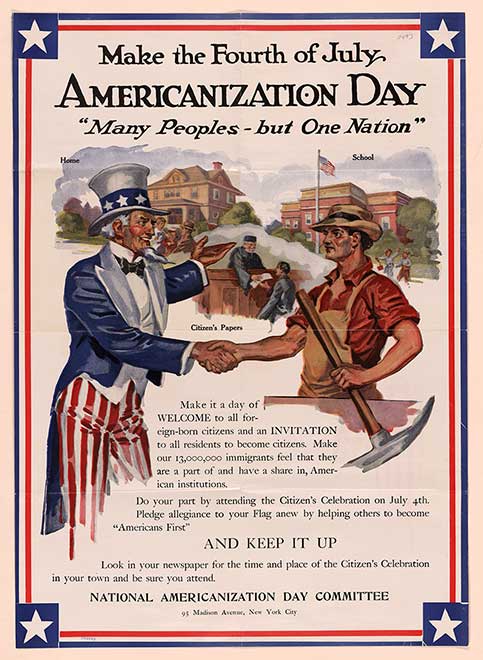This is a guest post by Ryan Reft, a historian in the Manuscript Division.
In the years immediately surrounding World War I, organizations like the New York National Americanization Day Committee hoped to use patriotic holidays such as the Fourth of July as a means to unify the country’s diverse populations.
By 1910, nearly a third of the United States’ 92 million residents were either born abroad or the progeny of parents who immigrated to America. The idea of “hyphenated Americans”—citizens who identified as Polish-American or Italian-American, for example—discomforted many native-born citizens. Former President Teddy Roosevelt insisted all citizens, no matter their birthright or ethnic heritage, embrace “the simple and loyal motto, America for Americans.” Future president Woodrow Wilson, too, expressed doubts about foreign-born citizens, worrying they might harbor “alien sympathies.”
Although Americans did not know it at the time, immigrants would soon prove critical to the country’s effort in World War I, both in military service and in industry. Despite their importance, America closed its borders in the years after the armistice, ending what had been the largest immigration flow in the country’s history.
The complicated experience of immigrants on the American home front during the WWI era is conveyed in the Library’s current exhibit “Echoes of the Great War: American Experiences of World War I,” which features artifacts from divisions across the Library. In addition, case files from the Manuscript Division’s Woodrow Wilson Papers shed further light on the wartime lives of American newcomers.
Whatever nativist doubts the native-born harbored, immigrants in 1917 poured themselves into the war effort. Nearly 500,000 servicemen in the newly conscripted army consisted of individuals born abroad in 46 different nations. Like their African-American counterparts, however, immigrants were over drafted: nearly 18 percent of enlisted men were foreign born despite making up less than 15 percent of the nation’s total population.

Letter in which Captain Ralston Flemming writes of his desire to instill a spirit of “militant Americanism” among immigrant soldiers.
Initially, the military subscribed to the 100-percent Americanism promoted by Roosevelt. U.S. Army Captain Ralston Flemming, for example, wrote of successful efforts at Camp Jackson in South Carolina to inculcate immigrants with “enthusiastic militant Americanism.” But the military soon adopted the gentler Americanization program of progressive reformers, which allowed for retention of cultural traditions. Congress also helped by passing legislation that enabled foreign-born soldiers to obtain expedited naturalization. Eventually, about 300,000 immigrant soldiers would attain citizenship through military service in the war.
On the home front, with immigrant labor concentrated in wartime industries—coal, steel, textiles, oil, lumber and many others—newcomers to the U.S. contributed mightily to mobilization and war work. At Bethlehem Steel, one of the largest wartime steel producers, nearly 10,000 of the plant’s 30,000 workers were immigrants.
Unions, too, saw an opportunity to expand through immigration. Historically, the American Federation of Labor (AFL) had expressed ambivalence and even reticence toward immigrant labor. But during the war, it incorporated the foreign born into the labor movement. AFL membership boomed, as did that of other unions, like the International Association of Machinists.

The New York Tribune featured a spread in its May 20, 2017, issue about the manufacture of artillery at Bethlehem Steel in Bethlehem, Pennsylvania, where nearly a third of workers were immigrants.
Still, government leaders and even unionists sometimes questioned the ability and loyalties of immigrant workers. Whatever his prewar beliefs regarding immigration, Wilson understood the importance of immigrants to the war effort. Recognizing the tension surrounding immigration, he dedicated July 4, 1918, to “immigrant America.” More importantly, he instituted war labor agencies like the National War Labor Board (NWLB) and the President’s Mediation Committee (PMC) to address the needs and anxieties of workers, particularly immigrant laborers who, due to their heavy concentration in industry, benefitted disproportionately from wartime labor reforms.
The NWLB and the PMC endorsed the idea of “shop committees,” internal plant representative bodies elected by workers to represent their demands to employers. To encourage participation, the NWLB used translators and “multilingual forms and announcements for shop committee ballots,” notes historian Joseph McCartin. As a result, in workplaces like Bethlehem Steel, immigrant participation exceeded expectations, and many became committee delegates. In this way, immigrants helped to deliver critical labor reforms during the war that benefitted all workers, even those who refused to, or were prevented from, joining unions.
After the armistice, changes in industry and immigration came swiftly as business leaders rolled back labor reforms established during the war. A massive wave of strikes followed, to which Attorney General A. Mitchell Palmer responded by deporting immigrants the government believed to be radicals.
Further, in 1921 and 1924, Congress passed immigration restriction laws that built on the Immigration Act of 1917, which had already imposed difficult hurdles to immigration, including a literacy test and an Asiatic barred zone. The result was greatly reduced immigration, particularly from Southern and Eastern Europe; Asians, excluding Filipinos, were banned from not only immigration, but even naturalization.
Many immigrants returning from U.S. military service in World War I discovered that the better jobs were reserved for the native born. During the war “the bosses then called all Italians ‘American people,’” one Italian worker commented. “Now they are foreigners.”
Before the war, observers such as Frank Trumbull, chairman of the National Americanization Day Committee, had warned that a failure to incorporate immigrants equitably would leave the nation vulnerable to riots, strikes and anarchist movements—Trumbull’s committee organized nationwide celebrations of America that involved immigrant participants. In some ways, sadly, Mr. Trumbull proved prescient.
World War I Centennial, 2017–18. With the most comprehensive collection of multiformat World War I holdings in the nation, the Library is a unique resource for primary source materials, education plans, public programs and on-site visitor experiences about the Great War including exhibits, symposia and book talks.

















